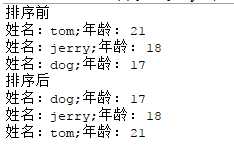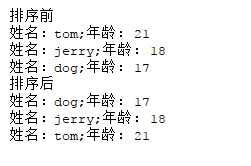package java.lang; import java.util.*; /** * This interface imposes a total ordering on the objects of each class that * implements it. This ordering is referred to as the class‘s <i>natural * ordering</i>, and the class‘s <tt>compareTo</tt> method is referred to as * its <i>natural comparison method</i>.<p> * * Lists (and arrays) of objects that implement this interface can be sorted * automatically by {@link Collections#sort(List) Collections.sort} (and * {@link Arrays#sort(Object[]) Arrays.sort}). Objects that implement this * interface can be used as keys in a {@linkplain SortedMap sorted map} or as * elements in a {@linkplain SortedSet sorted set}, without the need to * specify a {@linkplain Comparator comparator}.<p> * * The natural ordering for a class <tt>C</tt> is said to be <i>consistent * with equals</i> if and only if <tt>e1.compareTo(e2) == 0</tt> has * the same boolean value as <tt>e1.equals(e2)</tt> for every * <tt>e1</tt> and <tt>e2</tt> of class <tt>C</tt>. Note that <tt>null</tt> * is not an instance of any class, and <tt>e.compareTo(null)</tt> should * throw a <tt>NullPointerException</tt> even though <tt>e.equals(null)</tt> * returns <tt>false</tt>.<p> * * It is strongly recommended (though not required) that natural orderings be * consistent with equals. This is so because sorted sets (and sorted maps) * without explicit comparators behave "strangely" when they are used with * elements (or keys) whose natural ordering is inconsistent with equals. In * particular, such a sorted set (or sorted map) violates the general contract * for set (or map), which is defined in terms of the <tt>equals</tt> * method.<p> * * For example, if one adds two keys <tt>a</tt> and <tt>b</tt> such that * {@code (!a.equals(b) && a.compareTo(b) == 0)} to a sorted * set that does not use an explicit comparator, the second <tt>add</tt> * operation returns false (and the size of the sorted set does not increase) * because <tt>a</tt> and <tt>b</tt> are equivalent from the sorted set‘s * perspective.<p> * * Virtually all Java core classes that implement <tt>Comparable</tt> have natural * orderings that are consistent with equals. One exception is * <tt>java.math.BigDecimal</tt>, whose natural ordering equates * <tt>BigDecimal</tt> objects with equal values and different precisions * (such as 4.0 and 4.00).<p> * * For the mathematically inclined, the <i>relation</i> that defines * the natural ordering on a given class C is:<pre> * {(x, y) such that x.compareTo(y) <= 0}. * </pre> The <i>quotient</i> for this total order is: <pre> * {(x, y) such that x.compareTo(y) == 0}. * </pre> * * It follows immediately from the contract for <tt>compareTo</tt> that the * quotient is an <i>equivalence relation</i> on <tt>C</tt>, and that the * natural ordering is a <i>total order</i> on <tt>C</tt>. When we say that a * class‘s natural ordering is <i>consistent with equals</i>, we mean that the * quotient for the natural ordering is the equivalence relation defined by * the class‘s {@link Object#equals(Object) equals(Object)} method:<pre> * {(x, y) such that x.equals(y)}. </pre><p> * * This interface is a member of the * <a href="{@docRoot}/../technotes/guides/collections/index.html"> * Java Collections Framework</a>. * * @param <T> the type of objects that this object may be compared to * * @author Josh Bloch * @see java.util.Comparator * @since 1.2 */ public interface Comparable<T> { public int compareTo(T o); }
实现这个接口的类的集合或数组将会被自动排序通过Collections.sort或者Arrays.sort。同时,这个对象也可以被用来做Map或者Set的键值,而不需要另外制定一个比较器。
废话不多说了,直接举例子。
package object; public class Person implements Comparable<Object>{ private String name; private int age; Person(String name,int age){ this.name=name; this.age=age; } public int getAge() { return age; } public void setAge(int age) { this.age = age; } public String getName() { return name; } public void setName(String name) { this.name = name; } @Override public String toString() { return "姓名:"+this.name +";年龄: " + this.age; } @Override public int compareTo(Object o) { Person temp =null; if(o instanceof Person ) temp = (Person)(o); return this.age - temp.age; } }
测试类:
public class Test{ @org.junit.Test public void test(){ Person[] people = {new Person("tom",21),new Person("jerry",18),new Person("dog",17)}; System.out.println("排序前"); for(Person p:people) System.out.println(p); System.out.println("排序后"); java.util.Arrays.sort(people); for(Person p:people) System.out.println(p); } }
结果:

大家可以看到,这个排序方法是放到排序的对象类里面的,但是如果我们已经设计好了某类,而且不想改变其数据结构,就这可以用到比较器Comparator。用 Comparator 是策略模式,就是不改变对象自身,而用一个策略对象来改变它的行为。
package java.util; import java.io.Serializable; import java.util.function.Function; import java.util.function.ToIntFunction; import java.util.function.ToLongFunction; import java.util.function.ToDoubleFunction; import java.util.Comparators; @FunctionalInterface public interface Comparator<T> { int compare(T o1, T o2); boolean equals(Object obj); }
Comparator里面只有两个无实现体的接口方法,其它的方法有实现体,好像是新特性,暂时未用到。这里的equals与Object的equals方法类似。所以对于实现这个接口的类不必实现equals方法,也不会报错。
下面的例子我用的是匿名函数。
package object; public class Person{ private String name; private int age; Person(String name,int age){ this.name=name; this.age=age; } public int getAge() { return age; } public void setAge(int age) { this.age = age; } public String getName() { return name; } public void setName(String name) { this.name = name; } @Override public String toString() { return "姓名:"+this.name +";年龄: " + this.age; } }
测试类:
public class Test{ @org.junit.Test public void test(){ Person[] people = {new Person("tom",21),new Person("jerry",18),new Person("dog",17)}; System.out.println("排序前"); for(Person p:people) System.out.println(p); System.out.println("排序后"); Arrays.sort(people, new Comparator<Person>() { public int compare(Person o1, Person o2) { return o1.getAge()-o2.getAge();}; }); for(Person p:people) System.out.println(p); } }
结果:

总结:
用Comparable 简单, 只要实现Comparable 接口的对象直接就成为一个可以比较的对象,但是需要修改源代码,用Comparator 的好处是不需要修改源代码,而是另外实现一个比较器,当某个自定义的对象需要作比较的时候,把比较器和对象一起传递过去就可以比大小了,并且在Comparator 里面用户可以自己实现复杂的可以通用的逻辑,使其可以匹配一些比较简单的对象,那样就可以节省很多重复劳动了。
